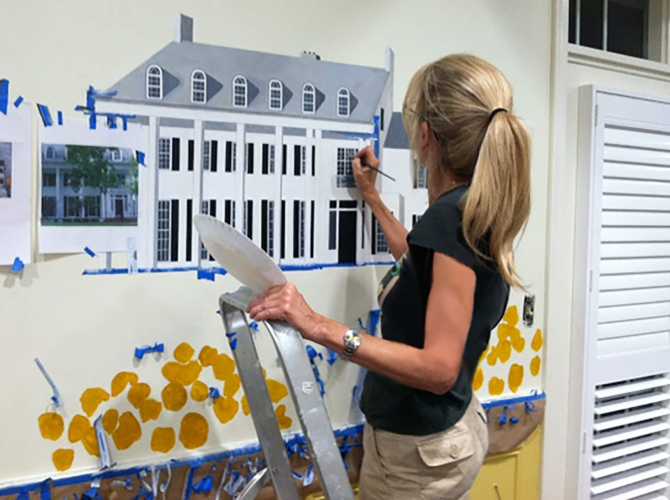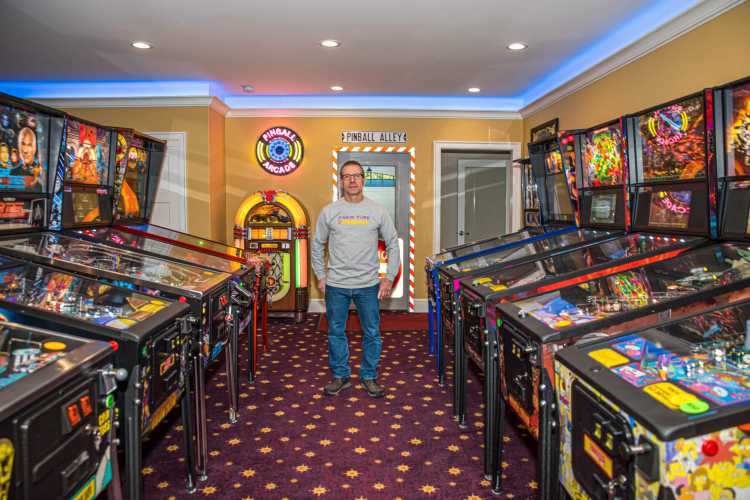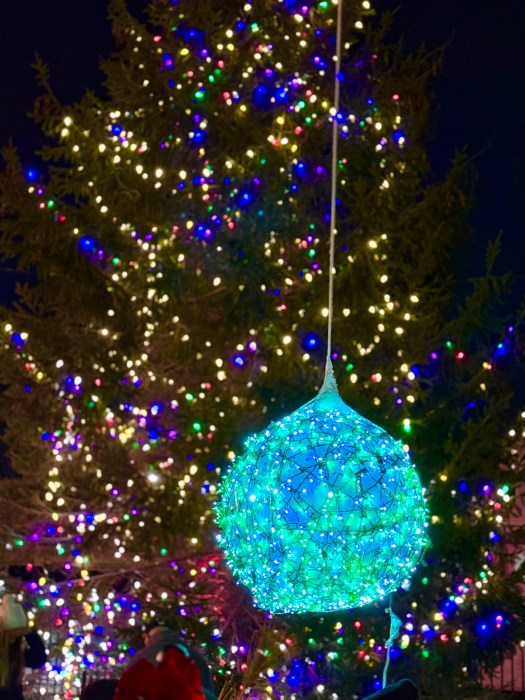Gregg Klewicki, also known as Gregg the Woodcarver, has left his mark on Long Island and is continuing to do so.
Bear carvings are his signature, particularly benches flanked by two brown bears holding up the seat with their paws. Made with locally harvested lumber, he creates sculptures, such as lighthouses and birds, ranging from about small enough to fit in your hand to 18 feet tall, and hand-carved signs. He also can make chainsaw woodcarvings from an existing tree on a property. Klewicki, who is 55 and lives in East Meadow, has made all sorts of woodwork on his own and by request carvings, from peacocks to aliens, across Long Island.
“Sometimes they give me a figure or pictures they want me to copy,” Klewicki says of commissions. “Sometimes I just wing it.” Wearing faded blue jeans and a jacket with a hood, Klewicki spoke near scaffolding between work in a courtyard near the Milleridge Inn in Jericho, which he uses as a workspace and an outdoor showroom of sorts. The al fresco gallery includes a dozen or more sculptures scattered around the inn, near the cafe, general store and bakery.
This kind of al fresco gallery includes a dozen or more sculptures scattered around Milleridge Village, near the cafe, general store and bakery.
“I found that I had talent with sculpture when I was about 20,” Klewicki says of an accidental discovery in the early 1990s.
He was at his sister-in-law’s college, where he saw a piece of window putty lying around. “I just picked it up and started making faces out of it,” he said.
“There was a party at the house that night. People kept picking it up, thinking I was an art student. I said, ‘I’m a truck driver.’ They said, ‘You’re in the wrong field.’”
He bought clay and experimented with it, making moulds and sculptures with resins. His brother Jim then suggested he try wood carving. He found a log in a vacant lot, brought it home, carved and displayed his work on his front lawn. A man offered him $100 initially and then went up to $450, which Klewicki accepted.
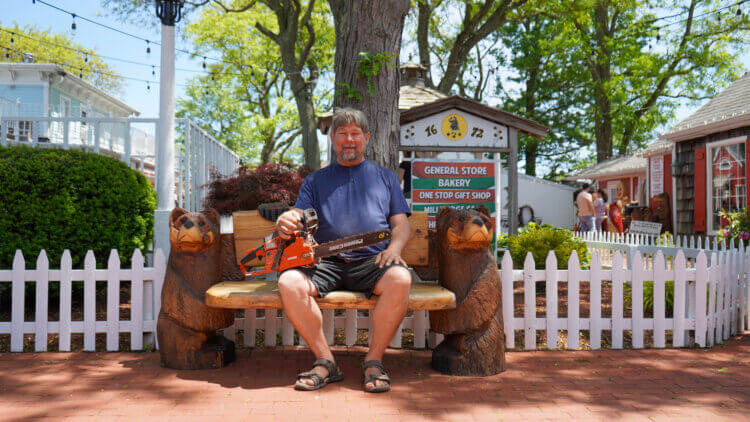
The man drove off with the carving in his trunk and Klewicki had found a calling and a career.
“He was going to give it to a friend as a gift for his birthday,” Klewicki says. “From that moment on, I thought, this is something people want and I can make, and I can make a profit on.”
Klewicki quit his job as a truck driver for a beer distributor in 1996 to take on woodworking full-time, first working with another carver. There were no YouTube videos to learn from at the time: After all, there was no YouTube.
“Cellphones didn’t even exist when I started,” he says. “I just did it. If it came out wrong, I did it again.”
He primarily picks up wood from tree removal companies and arborists who, otherwise, would have to dump it. He uses his pickup truck and, if the wood is larger, gets help from people with bigger trucks and cranes.
Klewicki primarily works with pine, spruce and cedar, although he sometimes uses oak, walnut and maple. Beechwood and locust, he says, can break the teeth of a saw, which he keeps sharp.
“I found that the machine took longer and caused it to get dull quick,” he says of sharpening saws. “So I use files now.”
He uses chainsaws from 14 inches to 3 feet long, grinders, sanders and hand tools, such as chisels. It takes two weeks to complete a typical commission or other large work he does for sale.
He has created a number of bears, dolphins, lighthouses and assorted shapes along with benches, as well as carving shapes into trunks of trees that have been taken down, turning stumps into sculptures.

“Whatever they want,” he says. “If they have a tree that they took down, they leave the trunk in the ground and I carve something out of the trunk.”
He recently carved eight birds into a tree stump in a bird sanctuary in Floral Park including a hawk, a cardinal, a blue jay, an owl, a woodpecker, a mourning dove and a few others.
Groucho Marx once asked, “Why a duck?” Why are bears so popular in carving?
“I think it goes back to people with their Teddy bear,” Klewicki speculates.
In addition to bears and birds, ranging from cardinals, eagles, owls, pelicans and others, he has carved dogs, cats and fish. He also has carved baseball bats, including a 19-foot-tall pine bat for Frank Catalanotto, who played for the New York Mets, Detroit Tigers, Texas Rangers, Toronto Blue Jays and Milwaukee Brewers, and is currently the Hofstra Pride baseball coach.
Klewicki stains, varnishes, seals and preserves, and sometimes paints his work, adding textures and colors. “Every one depends on what it requires,” he says.
He also has done a wide range of benches, including one with hummingbirds for a client in the Hamptons, as well as benches with bears, dogs and other animal shapes.
“I’ve had people request specific lighthouses, but they’re mostly from my imagination,” he says. “Some look like they’re made of brick. It depends what the customer wants.”
His work sells for $200 and up to several thousand dollars, typically. Customers buy for birthdays, anniversaries, Father’s Day, Mother’s Day, Christmas, Chanukah and all year long.

“When I first started, I thought I’d be doing all nautical stuff, because we’re on an island,” he says. “That’s not the case.”
Nevertheless, he does a lot of nautical work, such as crafting crabs, fish, lobsters and captains. He created a big sailfish and a pelican for Peter’s Clam Bar in Island Park. “I did a giant onsite, seven-foot marlin with tropical fish on the bottom,” he says of another commission.
Spring is busy, summer is “pretty good” and things pick up again in September. “December used to be insane,” Klewicki says, although it’s not as hectic as it once was.
If clients pay a little extra, he provides his signature, “G. Klewicki.”
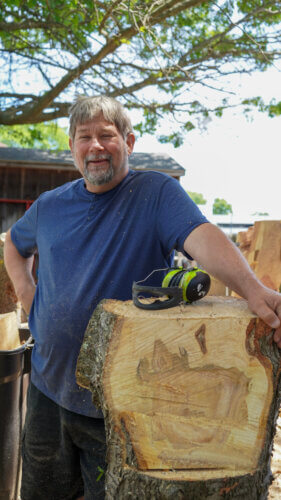
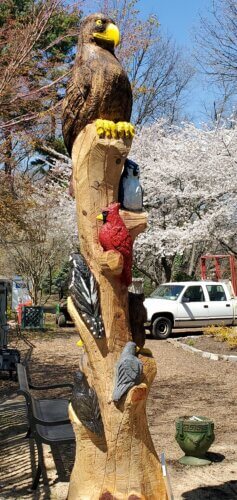
Although he has sold at stores, he no longer goes that route. He took second place at a juried art show at the Bethpage Golf Course a while ago, but doesn’t show at galleries.
“I steer away from making human things. They take a lot of time,” he says.
“A guy called me up and said, ‘I want you to make me some aliens.’ I made them. He took them home and put them around his pool in his backyard.”
People sometimes commission gag gifts and he has done a wide range of signs, including one for Driftwood Day Camp in Huntington.
The carvings last outside thanks to a varnish or other type of coating that helps preserve them. They typically have a lifespan of 10 to 20 years, he adds.
Klewicki advises customers to place carvings out of the path of irrigation so that water isn’t striking them in the same spot daily.
Customers can keep them clean by power washing and scrubbing the work if it shows grime.
“They average about 10 years and they can go as long as 20 or even longer,” Klewicki says.
“Mother Nature gets them all eventually, if they’re outdoors. I repair them when they need it.”
This article appeared in the June 9, 2023 issue of Behind The Hedges, as well as the June 2023 issue of Behind The Hedges Powered By the Long Island Press. Read the latest edition here. For previous Master Craftsman columns, click here.
Have a Master Craftsman to recommend? Email tvecsey@danspapers.com.


